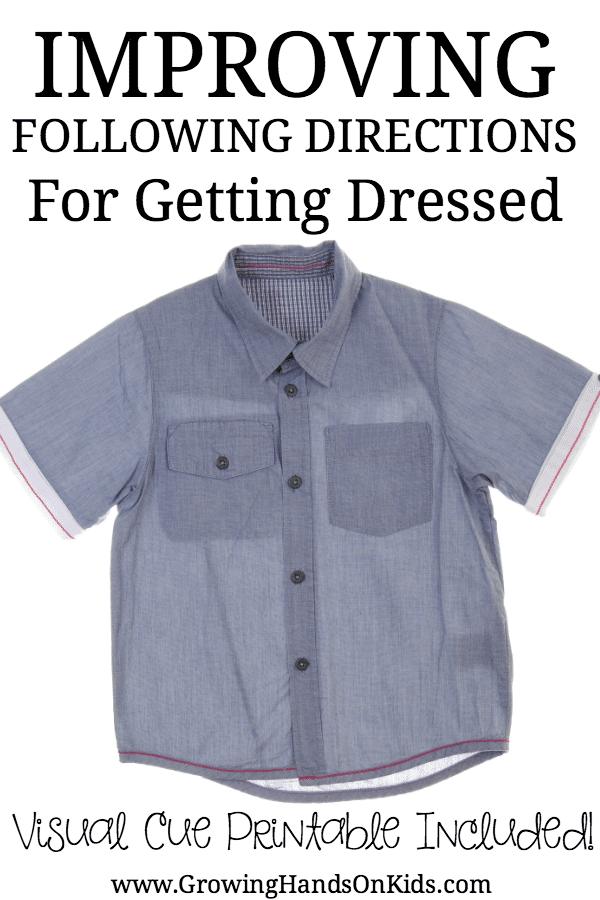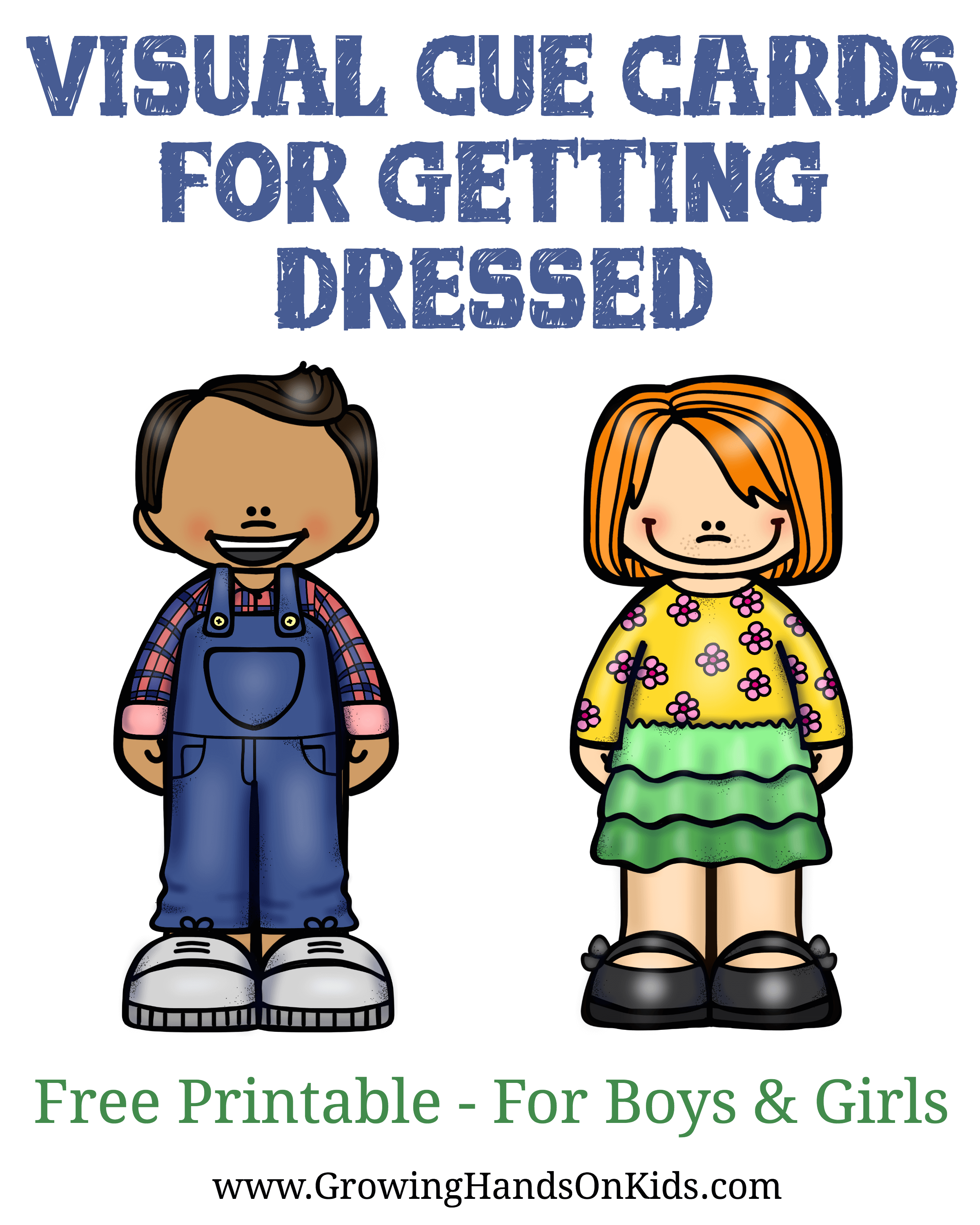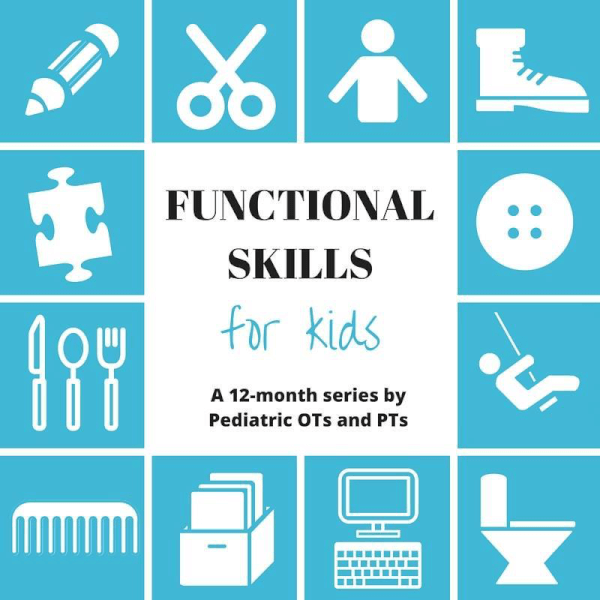Improving Following Directions with Getting Dressed for Kids
Affiliate and Referral links are used below to promote products I love and recommend. I receive a commission on any purchases made through these links. Please see my disclosure policy for more details. As an Amazon Associate, I earn from qualifying purchases.
This month in the Functional Skills for Kids series we are tackling dressing. It may seem like an easy task, but if your child is struggling with developmental challenges, getting dressed can be a difficult process. Today I'm going to be looking at following directions with getting dressed and how you can help out a child who may be having problems following all the steps and directions it takes for getting dressed.
There's also a free printable with today's post so keep reading!
Types of Directions and Getting Dressed
One thing that Occupational Therapists look at when a person is having problems with a specific skill is to do a task analysis and figure out all the steps needed for that activity and what the client is having problems with. For dressing the two therapy terms often used are donning (or putting on) or doffing (taking off) an item of clothing.
When you look at dressing step by step, there are a lot of things involved. You need different articles of clothing, all the pieces of clothing have various holes for different parts of the body, some go on from the bottom, others from the top.
With all the steps involved in dressing it can be very confusing, especially to a child who is already having problems following simple tasks and directions.
If your child is having problems following directions for getting dressed, there could be a couple of reasons for this.
- Do they not understand directional words/verbiage (prepositions): up, down, in-front, behind, through, over, under?
- Are they having problems following multiple step directions (go get your pants, shirt, underwear, and socks and put them all on)?
If they are not understanding directional words, as in they don't know how to move their body to put the piece of clothing above their heads, below them, or put their arms through, they will have a hard time following through with your verbal directions. They won't understand where the piece of clothing needs to go in order to be put on. Or where they need to put their arms, legs, etc in order to put on a piece of clothing.
When they have problems with multi-step directions, they could completely forget what items you asked them to get after the 1st or 2nd item and what they were suppose to do afterwards. Five minutes later you may find them doing something completely different in their room instead of getting the clothes or getting dressed.
Ways to Help Improve Direction Following
The best way to improve following directions is to break down the steps into manageable tasks and give visual cues instead of verbal.
Breaking your directions down into 1 or 2 steps can be so helpful. Instead of saying “Go to your room and get a shirt and then come back here.” say “Go to your room and stand by the dresser.” Once the child is there “Open the drawer and find a shirt.” Don't give every single step and direction at once, break it down into manageable parts and tasks. Once the first one is done, move on to the next step.
Maybe your child is struggling to remember all the items of clothing they need or where they are? Or they don't quite get the order that clothing needs to be put on? Creating a visual cue sheet can help them. Instead of having to repeat yourself over and over again and perhaps getting frustrated, using a visual cue gives them ownership of the task and allows for more independence, instead of relying on you to be constantly reminding.
Need a visual cue for your child? I've got a free printable for you down below, so keep reading!
For directional language and words, learning these words and movements with their entire bodies is so important. If they can understand what under, over, below, on top, etc. means with their body, they will understand how to manipulate a piece of clothing in these directions to put it on.
I always refer back to this motor skills preposition game by Totschooling for this skill. It is an excellent and FUN way to learn these preposition words for dressing. There's also a visual discrimination game she describes which is also perfect.
Visual Cue Cards for Dressing
I've got a free visual cue schedule for dressing for you today. I've included 2 boys and 2 girls in this set. Each page adds another item of clothing on top of the boy or girl that needs to be put on. Simply print out the pages (thick card stock will work better than regular paper) and you can also laminate if you want. Use velcro or glue dots and place the cue cards in order next to where your child needs to get dressed.
You can also use the word labels below each picture so they have words with each item, or print off extra labels to put on dressers so your child knows where items are (if your child can't read yet, just use the pictures as the labels instead on the front of your dressers).
DOWNLOAD YOUR FREE PRINTABLE HERE
Functional Skills for Kids Series
Come check out what all the other OTs and PTs have to say about dressing this month!
When Do Kids Start to Dress Themselves? | Mama OT
Fine Motor Requirements for Independence with Self-Dressing | Sugar Aunts
Gross Motor Skills and Independent Dressing | Your Therapy Source
Sensory Considerations for Dressing! | Your Kids OT
“Get Dressed!” How to Modify Your Child’s Dressing Routine | MissJaimeOT
Teaching Kids How to Dress Themselves: Activities to extend skills | The Inspired Treehouse
Improving Following Directions with Getting Dressed | Growing Hands-On Kids
Visual Perceptual Skills in Dressing | Kids Play Space
Work on Dressing Skills Through Play Activities | Therapy Fun Zone
Sharing with: Living Montessori Now, Hip Homeschool Moms, Teaching Mama, Christian Montessori Network, Homeschool Creations

Heather Greutman, COTA
Heather Greutman is a Certified Occupational Therapy Assistant with experience in school-based OT services for preschool through high school. She uses her background to share child development tips, tools, and strategies for parents, educators, and therapists. She is the author of many ebooks including The Basics of Fine Motor Skills, and Basics of Pre-Writing Skills, and co-author of Sensory Processing Explained: A Handbook for Parents and Educators.






I am so excited to start using this printable – so many of my families have trouble with getting their children to dress independently. I love the idea of using a visual schedule – Thank you! It’s important as therapists for us to remind parents that children with speech and language difficulties need simplification and other ways of understanding. These cues are perfect for a visual learner….
I hope they really help the parents you work with Jaime!
Cute printable! Good suggestion on learning prepositions to help understand all the complicated directions when learning how to get dressed.
Thanks so much Margaret!
I love how you mentioned that it’s important to only provide directions in 1-2 steps at a time. I am totally guilty of trying to tell my kids too many steps to complete when giving directions in order to get us all dressed and out the door. So important!
Me too! I was just catching myself doing this the other day with my daughter. Definitely an important reminder.